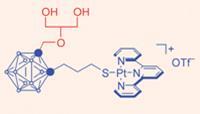A new complex for more effective delivery of closo-carborane agents to tumour sites has been developed by chemists in Australia.
A new complex for more effective delivery of closo-carborane agents to tumour sites has been developed by chemists in Australia.
Louis Rendina and colleagues from the University of Sydney and the University of Adelaide have increased the ability to obtain large cellular concentrations of boron by making the first example of a metal-containing carborane complex functionalised with a water-solubilising glycerol group.

Boron species are important in cancer treatments using boron neutron capture therapy (BNCT). Delivering them to the site of action is difficult because of their limited solubility in the body.
Rendina’s team had already discovered that platinum(ii)-carborane complexes can deliver boron near to DNA. Now, by modifying the synthesis, Rendina has incorporated a glycerol group into the complex. Not only does this aid delivery to aqueous media, it also increases the linker length in the complex which prevents the carborane interacting with the platinum(ii)-DNA binding process.
BNCT is a still an experimental cancer treatment, but new boron complexes, especially those that can also bind to DNA, might still be important.
This step holds great potential for the future treatment of cancerous cells, according to Rendina. ’We need to ensure that adequate amounts of boron can be delivered to the tumour cells. and to determine whether neutron irradiation of the new agents actually leads to an improved therapeutic effect,’ he said.
Sophia Anderton
References
E L Crossley, D Caiazza and L M Rendina, Dalton Trans., 2005, 2825 (DOI: 10.1039/<MAN>b508020g</MAN>)






No comments yet